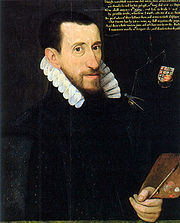
George Gower
Encyclopedia

English people
The English are a nation and ethnic group native to England, who speak English. The English identity is of early mediaeval origin, when they were known in Old English as the Anglecynn. England is now a country of the United Kingdom, and the majority of English people in England are British Citizens...
portrait painter who became Serjeant Painter
Serjeant Painter
The Serjeant Painter was an honorable and lucrative position with the British monarchy. It carried with it the prerogative of painting and gilding all of the King's residences, coaches, banners, etc. and it grossed over £ 1,000 in a good year by the 18th century...
to Queen Elizabeth I
Elizabeth I of England
Elizabeth I was queen regnant of England and Ireland from 17 November 1558 until her death. Sometimes called The Virgin Queen, Gloriana, or Good Queen Bess, Elizabeth was the fifth and last monarch of the Tudor dynasty...
in 1581.
Life
Little is known about his early life except that he was a grandson of Sir John Gower of Stettenham, YorkshireYorkshire
Yorkshire is a historic county of northern England and the largest in the United Kingdom. Because of its great size in comparison to other English counties, functions have been increasingly undertaken over time by its subdivisions, which have also been subject to periodic reform...
.
His earliest documented works are the two 1573 companion portraits of Sir Thomas Kytson and his wife Lady Kytson, now in the Tate Gallery
Tate Gallery
The Tate is an institution that houses the United Kingdom's national collection of British Art, and International Modern and Contemporary Art...
in London.
Gower painted a self-portrait
Self-portrait
A self-portrait is a representation of an artist, drawn, painted, photographed, or sculpted by the artist. Although self-portraits have been made by artists since the earliest times, it is not until the Early Renaissance in the mid 15th century that artists can be frequently identified depicting...
in 1579 (right) that shows his coat of arms
Coat of arms
A coat of arms is a unique heraldic design on a shield or escutcheon or on a surcoat or tabard used to cover and protect armour and to identify the wearer. Thus the term is often stated as "coat-armour", because it was anciently displayed on the front of a coat of cloth...
and his artist's tools of his trade. An allegorical
Allegory
Allegory is a demonstrative form of representation explaining meaning other than the words that are spoken. Allegory communicates its message by means of symbolic figures, actions or symbolic representation...
device shows a balance with an artist's dividers outweighing the family coat of arms, "a startling claim in England where a painter was still viewed as little more than an artisan."
.jpg)
Serjeant Painter
The Serjeant Painter was an honorable and lucrative position with the British monarchy. It carried with it the prerogative of painting and gilding all of the King's residences, coaches, banners, etc. and it grossed over £ 1,000 in a good year by the 18th century...
to Queen Elizabeth in 1581. This allowed him to paint most of England’s aristocracy. The post also made him responsible for painted decoration at the royal residences, and on coaches and furniture. Among his works were a fountain (now destroyed) and the astronomical clock, both at Hampton Court Palace
Hampton Court Palace
Hampton Court Palace is a royal palace in the London Borough of Richmond upon Thames, Greater London; it has not been inhabited by the British royal family since the 18th century. The palace is located south west of Charing Cross and upstream of Central London on the River Thames...
. He also inspected portraits of the Queen by other artists prior to their official release.
Gower's best-known work is the version of the Armada Portrait
Armada Portrait
The Armada Portrait of Elizabeth I of England is the name of any of three surviving versions of an allegorical panel painting depicting the Tudor queen surrounded by symbols of imperial majesty against a backdrop representing the defeat of the Spanish Armada in 1588.-Imagery:The combination of a...
of Elizabeth now at Woburn Abbey
Woburn Abbey
Woburn Abbey , near Woburn, Bedfordshire, England, is a country house, the seat of the Duke of Bedford and the location of the Woburn Safari Park.- Pre-20th century :...
, painted to commemorate the 1588 defeat of the Spanish Armada
Spanish Armada
This article refers to the Battle of Gravelines, for the modern navy of Spain, see Spanish NavyThe Spanish Armada was the Spanish fleet that sailed against England under the command of the Duke of Medina Sidonia in 1588, with the intention of overthrowing Elizabeth I of England to stop English...
. (A cut down version of this painting in the National Portrait Gallery (United Kingdom) is attributed to Gower; the "Drake" version is by a different hand.)
Gower died in London.

